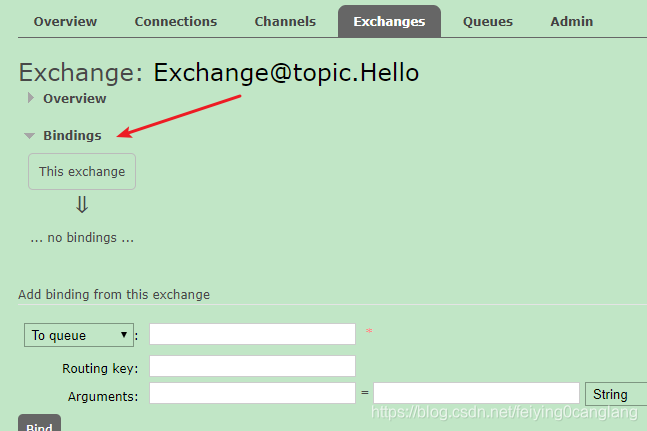原文网址:SpringBoot整合RabbitMQ--绑定交换机与队列--方法/实例_IT利刃出鞘的博客-CSDN博客
简介
本文用实例介绍SpringBoot中RabbitMQ如何绑定交换机(交换器)与队列。
配置方法概述
交换机
下边两种方式等价。
ExchangeBuilder.topicExchange(EXCHANGE_TOPIC_WELCOME).durable(true).build();new TopicExchange(EXCHANGE_TOPIC_WELCOME, true, false)队列
下边两种方式等价
QueueBuilder.durable("Hi").build();new Queue(QUEUE_HI, true)绑定
下边两种方式等价
注意:第一种的参数并不是字符串。
BindingBuilder.bind(helloQueue).to(welcomExchange).with("hello.#")
new Binding("Queue@hello", Binding.DestinationType.QUEUE,
"[email protected]", "hello.#", null)法1:配置类(简洁方法)(推荐)
package com.example.config;
import org.springframework.amqp.core.*;
import org.springframework.beans.factory.annotation.Autowired;
import org.springframework.context.annotation.Bean;
import org.springframework.context.annotation.Configuration;
@Configuration
public class RabbitMQRouterConfig {
public static final String QUEUE_HELLO = "Queue@hello";
public static final String QUEUE_HI = "Queue@hi";
public static final String EXCHANGE_TOPIC_WELCOME = "[email protected]";
public static final String ROUTINGKEY_HELLOS = "hello.#";
@Autowired
private AmqpAdmin amqpAdmin;
@Bean
public Object initBindingTest() {
amqpAdmin.declareExchange(new TopicExchange(EXCHANGE_TOPIC_WELCOME, true, false));
amqpAdmin.declareQueue(new Queue(QUEUE_HI, true));
amqpAdmin.declareQueue(new Queue(QUEUE_HELLO, true));
amqpAdmin.declareBinding(new Binding(QUEUE_HELLO, Binding.DestinationType.QUEUE,
EXCHANGE_TOPIC_WELCOME, ROUTINGKEY_HELLOS, null));
return new Object();
}
}amqpAdmin.declareBinding
需要一个Binding对象作为参数
- exchange:交换器名称
- type:交换器类型。BuiltinExchangeType枚举类,有以下4中类型交换器:DIRECT(“direct”), FANOUT(“fanout”), TOPIC(“topic”), HEADERS(“headers”)
- durable:设置是否持久化。true:持久化,false:非持久化。持久化可以将交换器存盘,在服务器重启时不会丢失相关消息。
- autoDelete:设置是否自动删除。true:自动删除,false:不自动删除。自动删除的前提是至少有一个队列或交换器与这个交换器绑定,之后所有与这个交换器绑定的队列或交换器都与此交换器解绑。
- internal:设置是否内置的。true:内置交换器,false:非内置交换器。内置交换器,客户端无法直接发送消息到这个交换器中,只能通过交换器路由到交换器这种方式。
- arguments:其他一些结构化参数。如备份交换器:alternate-exchange、超时时间。示例配置超时时间方法:
Map<String, Object> params = new HashMap();
params.put("x-message-ttl", 2000);
amqpAdmin.declareBinding(new Binding(QUEUE_HELLO, Binding.DestinationType.QUEUE,
EXCHANGE_TOPIC_WELCOME, ROUTINGKEY_HELLOS, params));法2:配置类(繁琐方法)(不推荐)
不推荐的原因
适用于队列和交换器不多时。
代码示例
package com.lly.order.message;
import org.springframework.amqp.core.*;
import org.springframework.context.annotation.Bean;
import org.springframework.context.annotation.Configuration;
@Configuration
public class RabbitMQConfig {
public final static String QUEUE_DIRECT = "Queue@direct";
public final static String QUEUE_TOPIC_ONE = "Queue@topic_one";
public final static String TOPIC_QUEUE_TWO = "Queue@topic_two";
public final static String QUEUE_FANOUT_ONE = "Queue@fanout_one";
public final static String QUEUE_FANOUT_TWO = "Queue@fanout_two";
public final static String EXCHANGE_TOPIC = "Exchange@topic";
public final static String EXCHANGE_FANOUT = "Exchange@fanout";
public final static String ROUTINGKEY_TOPIC_ONE = "hello.key";
public final static String ROUTINGKEY_TOPIC_TWO = "*.key";
// direct模式队列
@Bean
public Queue directQueue() {
return new Queue(QUEUE_DIRECT, true);
}
// topic 订阅者模式队列
@Bean
public Queue topicQueueOne() {
return new Queue(QUEUE_TOPIC_ONE, true);
}
@Bean
public Queue topicQueueTwo() {
return new Queue(TOPIC_QUEUE_TWO, true);
}
// fanout 广播者模式队列
@Bean
public Queue fanoutQueueOne() {
return new Queue(QUEUE_FANOUT_ONE, true);
}
@Bean
public Queue fanoutQueueTwo() {
return new Queue(QUEUE_FANOUT_TWO, true);
}
// topic 交换器
@Bean
public TopicExchange topExchange() {
return new TopicExchange(EXCHANGE_TOPIC);
}
// fanout 交换器
@Bean
public FanoutExchange fanoutExchange() {
return new FanoutExchange(EXCHANGE_FANOUT);
}
// 订阅者模式绑定
@Bean
public Binding topicExchangeBingingOne() {
return BindingBuilder.bind(topicQueueOne()).to(topExchange()).with(ROUTINGKEY_TOPIC_ONE);
}
@Bean
public Binding topicExchangeBingingTwo() {
return BindingBuilder.bind(topicQueueTwo()).to(topicExchange()).with(ROUTINGKEY_TOPIC_TWO);
}
// 广播模式绑定
@Bean
public Binding fanoutExchangeBingingOne() {
return BindingBuilder.bind(fanoutQueueOne()).to(fanoutExchange());
}
@Bean
public Binding fanoutExchangeBingingTwo() {
return BindingBuilder.bind(fanoutQueueTwo()).to(fanoutExchange());
}
}法3:使用方配置(不推荐)
不推荐的原因
RabbitMQ的配置最好是统一在一个地方配置,分散配置不利于后期维护。
使用方法
@Component
public class Receiver {
@RabbitListener(queues = "hello")
public void process(String hello) {
System.out.println ("Receiver : " + hello);
}
@RabbitListener(bindings = @QueueBinding(
exchange = @Exchange(value = "[email protected]",durable = "true",type = "topic"),
value = @Queue(value = "Queue@Hello",durable = "true"),
key = "key.#"
))
public void processMessage1(Message message) {
System.out.println(message);
}
}法4:MQ服务端网页(不推荐)
不推荐的原因
使用方法
添加交换器
http://localhost:15672/#/exchanges //例如:[email protected]
添加队列
http://localhost:15672/#/queues //例如:Queue@Hello
交换器添加路由键
http://localhost:15672/#/exchanges=> 点击交换器名字=> Binding=> 添加队列与路由

